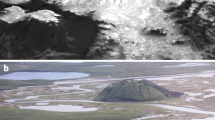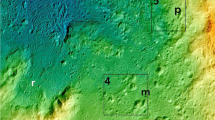Abstract
Before NASA’s Dawn mission, the dwarf planet Ceres was widely believed to contain a substantial ice-rich layer below its rocky surface. The existence of such a layer has significant implications for Ceres’s formation, evolution, and astrobiological potential. Ceres is warmer than icy worlds in the outer Solar System and, if its shallow subsurface is ice-rich, large impact craters are expected to be erased by viscous flow on short geologic timescales. Here we use digital terrain models derived from Dawn Framing Camera images to show that most of Ceres’s largest craters are several kilometres deep, and are therefore inconsistent with the existence of an ice-rich subsurface. We further show from numerical simulations that the absence of viscous relaxation over billion-year timescales implies a subsurface viscosity that is at least one thousand times greater than that of pure water ice. We conclude that Ceres’s shallow subsurface is no more than 30% to 40% ice by volume, with a mixture of rock, salts and/or clathrates accounting for the other 60% to 70%. However, several anomalously shallow craters are consistent with limited viscous relaxation and may indicate spatial variations in subsurface ice content.
This is a preview of subscription content, access via your institution
Access options
Subscribe to this journal
Receive 12 print issues and online access
$259.00 per year
only $21.58 per issue
Buy this article
- Purchase on Springer Link
- Instant access to full article PDF
Prices may be subject to local taxes which are calculated during checkout




Similar content being viewed by others
References
Rivkin, A. S. et al. The surface composition of Ceres. Space Sci. Rev. 163, 95–116 (2011).
De Sanctis, M. C. et al. Ammoniated phyllosilicates with a likely outer Solar System origin on (1) Ceres. Nature 528, 241–244 (2015).
Ammannito, E. et al. The distribution of phyllosilicates on Ceres. Lunar Planet. Sci. Conf. 47, 3020 (2016).
Park, R. S. et al. Gravity science investigation of Ceres from Dawn. Lunar Planet. Sci. Conf. 47, 1781 (2016).
Russell, C. T. & Raymond, C. A. The dawn mission to Vesta and Ceres. Space Sci. Rev. 163, 3–23 (2011).
Thomas, P. C. et al. Differentiation of the asteroid Ceres as revealed by its shape. Nature 437, 224–226 (2005).
Castillo-Rogez, J. C. & McCord, T. B. Ceres evolution and present state constrained by shaped data. Icarus 205, 443–459 (2010).
McCord, T. B. & Sotin, C. Ceres: evolution and current state. J. Geophys. Res. 110, E05009 (2005).
Roberts, J. H. & Rivkin, A. S. The fate of Ceres’ original crust. AAS Div. Planet. Sci. Conf. 47, 212.07 (2015).
Zolotov, M. Y. On the composition and differentiation of Ceres. Icarus 204, 183–193 (2009).
Castillo-Rogez, J. C. Ceres—Neither a porous nor salty ball. Icarus 215, 599–602 (2011).
Hayne, P. O. & Aharonson, O. Thermal stability of ice on Ceres with rough topography. J. Geophys. Res. 120, 1567–1584 (2015).
Bland, M. T. Predicted crater morphologies on Ceres: probing internal structure and evolution. Icarus 226, 510–521 (2013).
Schenk, P. M. et al. Impact cratering on the small planets Ceres and Vesta: S-C transitions, central pits and the origin of the bright spots. Lunar Planet. Sci. Conf. 47, 2697 (2016).
Marchi, S. et al. Cratering on Ceres: the puzzle of the missing large craters. Lunar Planet Sci. Conf. 47, 1281 (2016).
Raymond, C. A. et al. The Dawn topography investigation. Space Sci. Rev. 163, 487–510 (2011).
White, O. L. & Schenk, P. M. Crater shapes on the saturnian satellites: new measurements using Cassini stereo images. Lunar Planet Sci. Conf. 42, 2283 (2011).
Bray, V. J., Collins, G. S., Morgan, J. V. & Schenk, P. M. The effects of target properties on crater morphology: comparison of central peak craters on the Moon and Ganymede. Meteorit. Planet. Sci. 43, 1979–1992 (2008).
Pike, R. J. in Impact and Explosion Cratering (eds Roddy, D. J., Pepin, R. O. & Merill, R. B.) 489–509 (Pergamon, 1977).
Barr, A. C. & McKinnon, W. B. Convection in ice I shells and mantles with self-consistent grain size. J. Geophys. Res. 112, E02012 (2007).
Durham, W. B. & Stern, L. A. Rheological properties of water ice—Applications to satellites of the outer planets. Annu. Rev. Earth Planet. Sci. 29, 295–330 (2001).
Ermakov, A. I. et al. Evaluation of Ceres’ compensation state. Lunar Planet. Sci. Conf. 47, 1708 (2016).
Roscoe, R. The viscosity of suspensions of rigid spheres. Br. J. Appl. Phys. 3, 267–269 (1952).
Friedson, A. J. & Stevenson, D. J. Viscosity of rock-ice mixtures and applications to the evolution of the icy satellites. Icarus 56, 1–14 (1983).
Durham, W. B., Kirby, S. H. & Stern, L. A. Effects of dispersed particulated on the rheology of water ice at planetary conditions. J. Geophys. Res. 97, 20883–20897 (1992).
Durham, W. B., Pathare, A. V., Stern, L. A. & Lenferink, H. J. Mobility of icy sand packs, with application to Martian permafrost. Geophys. Res. Lett. 36, L23203 (2009).
Mangold, N., Allemand, P., Duval, P., Geraud, Y. & Thomas, P. Experimental and theoretical deformation of ice-rock mixtures: implications on rheology and ice content of Martian permafrost. Planet. Space. Sci. 50, 385–401 (2002).
McCarthy, C., Cooper, R. F., Goldsby, D. L., Durham, W. B. & Kirby, S. H. Transient and steady state creep response of ice I and magnesium sulfate hydrate eutectic aggregates. J. Geophys. Res. 116, E04007 (2011).
Durham, W. B., Prieto-Ballesteros, O., Goldsby, D. L. & Kargel, J. S. Rheology and thermal properties of icy material. Space Sci. Rev. 153, 273–298 (2010).
De Sanctis, M. C. et al. Bright carbonate deposits as evidence of aqueous alteration on (1) Ceres. Nature http://dx.doi.org/10.1038/nature18290 (2016).
Nathues, A. et al. Sublimation in bright spots on (1) Ceres. Nature 528, 237–240 (2015).
Melosh, H. J. Impact Cratering: A Geologic Process (Oxford Univ. Press, 1989).
Parmentier, E. M. & Head, J. W. Viscous relaxation of impact craters on icy planetary surfaces: determination of viscosity variation with depth. Icarus 47, 100–111 (1981).
Melosh, H. J. & Raefsky, A. The dynamical origin of subduction zone topography. Geophys. J. R. Astron. Soc. 60, 333–334 (1980).
Dombard, A. J. & McKinnon, W. B. Elastoviscoplastic relaxation of impact crater topography with application to Ganymede and Callisto. J. Geophys. Res. 111, E01001 (2006).
Ranalli, G. The Rheology of the Earth 76–77 (Chapman and Hall, 1995).
Bland, M. T. & McKinnon, W. B. Forming Europa’s folds: strain requirements for the production of large-amplitude deformation. Icarus 221, 694–709 (2012).
De La Chappelle, S., Castelnau, O., Lipenkov, V. & Duval, P. Dynamic recrystallization and texture development in ice as revealed by the study of the deep ice cores in Antarctica and Greenland. J. Geophys. Res. 103, 5091–5105 (1998).
Souchez, R. A. & Lorrain, R. D. Ice Composition and Glacier Dynamics (Springer, 1991).
Pathare, A. V., Paige, D. & Turtle, E. Viscous relaxation of craters within the Martian south polar layered deposits. Icarus 174, 396–418 (2005).
Sori, M. M., Byrne, S., Hamilton, C. W. & Landis, M. E. Viscous flow rates of icy topography on the north polar layered deposits of Mars. Geophys. Res. Lett. 43, 3060–3068 (2016).
Acknowledgements
M.T.B. thanks Trent Hare for ArcGIS support. This work was supported by NASA’s Dawn Guest Investigator Program (NNH15AZ85I).
Author information
Authors and Affiliations
Contributions
M.T.B. measured all craters, designed, performed and analysed all simulations, and wrote the manuscript. P.M.S. provided comparison data for crater depths on planetary bodies and discussed the results and implications of the observations and simulations. T.K., J.H.P. and H.H. provided crater counts for Coniraya and Vinotonus and discussed implications of the results. F.P. and R.S.P. created and provided the DTMs used to measure crater depths. C.A.R., R.R.F., J.C.C.-R., S.D.K. and S.M. provided substantive discussion of the observations, simulations and implications for Ceres’ near-surface composition, and provided critical comments on the manuscript at all stages of development. C.T.R. is responsible for the Dawn mission and all data acquisition.
Corresponding author
Ethics declarations
Competing interests
The authors declare no competing financial interests.
Supplementary information
Supplementary Information
Supplementary Information (PDF 5917 kb)
Rights and permissions
About this article
Cite this article
Bland, M., Raymond, C., Schenk, P. et al. Composition and structure of the shallow subsurface of Ceres revealed by crater morphology. Nature Geosci 9, 538–542 (2016). https://doi.org/10.1038/ngeo2743
Received:
Accepted:
Published:
Issue Date:
DOI: https://doi.org/10.1038/ngeo2743
This article is cited by
-
Volcanism in the Solar System
Science China Earth Sciences (2023)
-
Determining the Relative Cratering Ages of Regions of Psyche’s Surface
Space Science Reviews (2022)
-
GAUSS - genesis of asteroids and evolution of the solar system
Experimental Astronomy (2021)
-
Fresh emplacement of hydrated sodium chloride on Ceres from ascending salty fluids
Nature Astronomy (2020)
-
Impact heat driven volatile redistribution at Occator crater on Ceres as a comparative planetary process
Nature Communications (2020)



